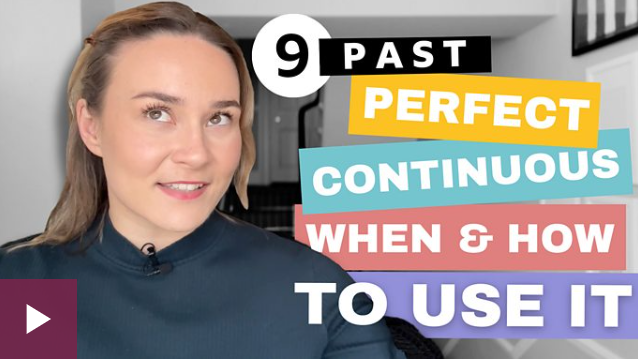USES OF PAST PERFECT CONTINUOUS
To describe an ongoing action that stops at a point in the past. Combine it with the past simple.
- Before she arrived, I had been waiting for more than an hour. (I stopped waiting when she arrived)
- Before the storm hit, people had been enjoying the sunny weather. (They stopped enjoying the weather when the storm hit)
To explain the result of something that was happening in the past. Also combine it with the past simple.
- She missed the bus because she had been talking on the phone and lost track of time.
- The room smelled delicious because Jeff had been cooking a spicy curry.
To tell someone what someone else said.
- “I’ve been studying all morning.”
- Becomes: Georgie said she had been studying all morning.
- “I’ve been sleeping so I didn’t hear the doorbell.”
- Becomes: Georgie said she’d been sleeping so she hadn’t heard the doorbell.
Useful vocabulary: for (durations) and since (from a point in time)
STRUCTURE
For positive sentences, use ‘had been’ plus the main verb with ‘ing’. We usually contract the form with an apostrophe.
- I had been walking > I‘d been walking
- You had been walking > You‘d been walking
- He had been walking > He‘d been walking
- She had been walking > She‘d been walking
- It had been walking > It‘d been walking
- We had been walking > We‘d been walking
- They had been walking > They‘d been walking
For negative sentences, add ‘not’ after ‘had’. We usually contract the form with an apostrophe.
- I had not been walking > I hadn’t been walking
- You had not been walking > You hadn’t been walking
- He had not been walking > He hadn’t been walking
- She had not been walking > She hadn’t been walking
- It had not been walking > It hadn’t been walking
- We had not been walking > We hadn’t been walking
- They had not been walking > They hadn’t been walking
To ask yes/no questions, change the order of the sentence so that ‘had’ is at the beginning.
- Had I been walking?
- Yes, you had
- No, you hadn’t
- Had you been walking?
- Yes, I had
- No, I hadn’t
- Had he been walking?
- Yes, he had
- No, he hadn’t
- Had she been walking?
- Yes, she had
- No, she hadn’t
- Had it been walking?
- Yes, it had
- No, it hadn’t
- Had we been walking?
- Yes, we had
- No, we hadn’t
- Had they been walking?
- Yes, they had
- No, they hadn’t
It’s also very common to begin a question with ‘How long…’ followed by these structures to ask about the duration of an action.
- How long had you been studying English by the time you did the B2 exam?
- I’d been studying English for 3 years.
To ask for more information, add the ‘who, what, where, why, how, when’ question words at the beginning.
- Why had I been walking?
- Who had you been walking with?
- Where had he been walking?
- When had she been walking?
- How had they been walking?
- When had they been walking?
